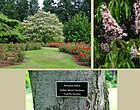Note: This is a project under development. The articles on this wiki are just being initiated and broadly incomplete. You can Help creating new pages.
Aesculus indica - Indian horse chestnut
Pangara is a temperate deciduous tree in the soapnut family, native to the western Himalayan region. They grow at altitudes from 1800 - 3000 m.
Contents
- 1 Uses
- 2 Parts Used
- 3 Chemical Composition
- 4 Common names
- 5 Properties
- 6 Habit
- 7 Identification
- 8 List of Ayurvedic medicine in which the herb is used
- 9 Where to get the saplings
- 10 Mode of Propagation
- 11 How to plant/cultivate
- 12 Commonly seen growing in areas
- 13 Photo Gallery
- 14 References
- 15 External Links
Uses
Parts Used
Chemical Composition
The leaves contain aescin, quercetin and beta-sitosterol. Stems also contain rutin, astragalin, aesculin. Seeds contain aescin, aesculuside A and B, also aliphatic esters.[1]
Common names
| Language | Common name |
|---|---|
| Kannada | |
| Hindi | akhnor, bankhor, goon, gun, khanir, khanoor, khanor, pangar, pangara |
| Malayalam | |
| Tamil | |
| Telugu | |
| Marathi | NA |
| Gujarathi | NA |
| Punjabi | NA |
| Kashmiri | NA |
| Sanskrit | |
| English | Indian Horse Chestnut |
Properties
Reference: Dravya - Substance, Rasa - Taste, Guna - Qualities, Veerya - Potency, Vipaka - Post-digesion effect, Karma - Pharmacological activity, Prabhava - Therepeutics.
Dravya
Rasa
Guna
Veerya
Vipaka
Karma
Prabhava
Habit
Identification
Leaf
| Kind | Shape | Feature |
|---|---|---|
| Digitate | Opposite | The leaves are large, opposite, digitate, glossy, laceolate ( Boat shaped),margin entire and venation pinnate, it forms a umbel shaped at the branch apex |
Flower
| Type | Size | Color and composition | Stamen | More information |
|---|---|---|---|---|
| bisexual | terminal panicle | white | the flowers are found in a long stack about 40 cm long and bearing about 300 flowers |
Fruit
| Type | Size | Mass | Appearance | Seeds | More information |
|---|---|---|---|---|---|
| Fleshy capsules | Large brown seeds | {{{6}}} |
Other features
List of Ayurvedic medicine in which the herb is used
Where to get the saplings
Mode of Propagation
How to plant/cultivate
Season to grow
Soil type
Propagation
Commonly seen growing in areas
Photo Gallery
References
- ↑ "Chemical constituents"
- ↑ Cite error: Invalid
<ref>tag; no text was provided for refs namedCommon names - ↑ "BOTANIC DESCRIPTION"


